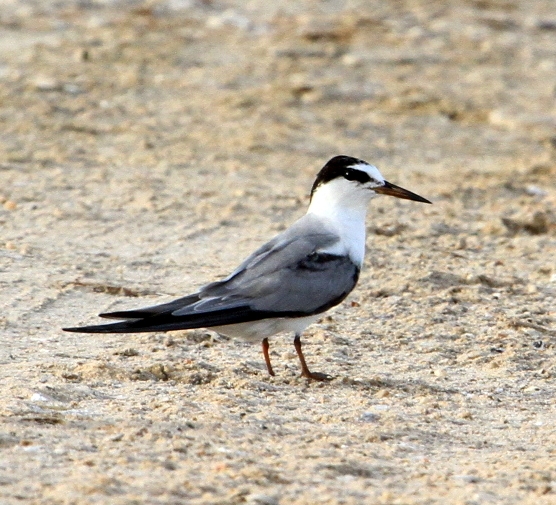New Articles
New race of Little Tern Sternula albifrons for Mediterranean found breeding in Egypt
Norman Deans van Swelm
In Sandgrouse 38 (2016) 118-123 Mohamed Habib reports in detail on his survey of Little Tern Sternula albifrons colonies including behavioural aspects at Port Said, Egypt. His report has been illustrated with a set of very interesting photographs of the species breeding behaviour and adaptation to the harsh climate such as cooling chicks by covering them with water by means of soaked belly feathers. From the pictures it appeared that the Little Terns of Port Said had an unusually dark plumage compared to the little Terns from Europe.
At my request Mr.Habib visited the colonies near Port Said again in order to trap, measure, collecting some feathers and to photograph breeding Little Terns. See results table 1 and 2.
Of 81 ad Little Terns trapped in the breeding season in the Dutch delta region between 1984-86 9 had only one (P10) black outer primary; 62 had two (P9-10) black outer primaries; 10 had three (P8-9-10) black outer primaries. See also pictures taken recently showing this. The outer primaries are black except for a white border to the basal inner web. The remaining primaries 1-8/9/ are pale grey.
Plumage of ad Little Terns in Port Said, Egypt
From 24th June till 10th July 2016 Mohamed Habib managed to trap 9 adult Little Terns on the nest in Port Said. Of these 7 individuals had P9-10 black and only one just P10.
Contrary to the European Little Tern the adult Port Said Little Terns have darker grey upperparts including rump and tail. Quite striking are the very dark grey primaries 3-6 which at times seem to be all black in flight when worn to the extent that 50% of the wing looks black. During breeding plumages bleach somewhat but the upperparts remain darker grey than NW European Little Terns.
As can be seen from the pictures Port Said Little Terns moult primaries ahead of NW European Little Terns. At or around 1st July 8 Port Said Terns had two freshly moulted inner primaries and P3 growing hence a moult score of little more than 10. A score NW European Little Terns may reach at the earliest at 20th July (see Meininger et al, 1987).
If our eyes do not deceive us the eyes of Port Said Little are slightly bigger in diameter than the eyes of NW European Little Terns. If this is correct it may be an adaptation to the shorter days in Egypt during the breeding season with only 14 hours and 10 minutes of daylight on 21st June compared to 16 hours and 42 minutes in Rotterdam at the same day. Bigger eyes may help the terns to keep on fishing after dusk. See results table 3.
The eggs in Egypt are somewhat duller, more brown coloured than in NW Europe the latter are paler and better adapted to the typical sandy beaches.
The same is true for downy chicks from Port Said , more vividly coloured and less ‘blond’than their European counterparts
In juvenal plumage the Port Said Little Terns are also somewhat livelier colored than the NW. European terns, see pictures.
Copulation
Among North Sea Little Terns a copulation goes hand in hand with presenting food. No food, no copulation! While mounting his partner the male lets the Sandeel gently touch the back of the female to stimulate her, while copulating she may eat the fish at the same time. In the picture of the Port Said Little Tern copulation there is no fish to be seen.
Name proposal
Vaurie,1965, mentioned only two races for the Little Tern occurring in the Western Palearctic i.c. nominate albifrons and far eastern sinensis. C.S.Roselaar in Cramp, 1985 notes small differences in size of nominate to the southern part of it’s range but other than that supports Vaurie as far as 2 races for the Western Palearctic are concerned, Malling Olsen c.s. too accept only two races for the WP. Clearly these authors have not been in the position to see the the very dark little Terns of northern Egypt in particular the breeding birds of the Port Said area.
Due to the differences described here I propose to name the Little Tern from the southeast corner of the Mediteranean
Malaka’s Little Tern Sternula albifrons habibi,
DNA samples of both Port Said Little Terns as well as Little Terns from the North Sea area (The Netherlands) have been send to Prof.Jon M.Collinson ,University of Aberdeen,Scotland for further analyses.
*Acknowledgements*
I thank the Foundation Voorne Bird Observatory and Lars Lachmann for their assistence.
*Referencis*
Cramp, S. (red.) 1985.The Birds of the Western Palearctic, Vol.5. Oxford University Press.
Glutz von Blotheim, Urs N.1982.Handbuch der Vogel Mitteleuropas Band 8/II.Frankfurt
Habib, Mohamed, 2016. A survey of Little Tern Sternula albifrons colonies at Port Said, Egypt, in 2015 with notes on behavior. Sandgrouse 38:118-123.
Malling Olsen,Klaus & Hans Larsson. 1995. Terns of Europe ans North America. Bloomsbury, London.
Meininger,P.L.,van Swelm,N.D. & Swennen,C.1987. Biometrics, moult, and origin of Little Terns Sterna albifrons in S.W.Netherlands. Limosa 60 (2):75-83.
Schonwetter, M. 1967. Handbuch der Oologie 1. Berlin.
Vaurie, Charles. 1965. The Birds of the Western Palearctic Fauna Non Passeriformes. Witherby,London.
citation:
Deans van Swelm,Norman. 2018. New race of Little Tern Sternula albifrons for Mediterranean found breeding in Egypt.
Radioactiverobins.com
Results
Table 1
External measurements of adult Little Terns trapped in Port Said,Egypt





